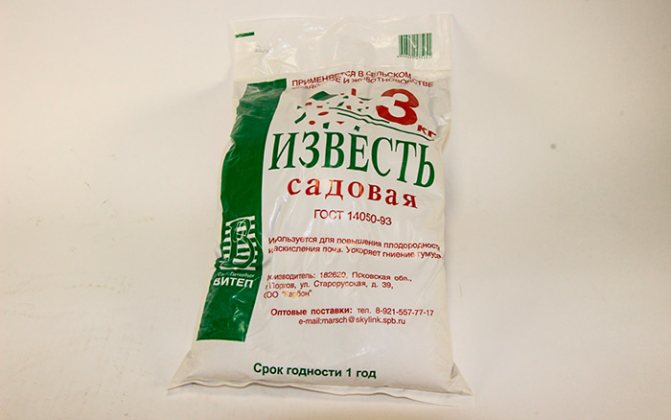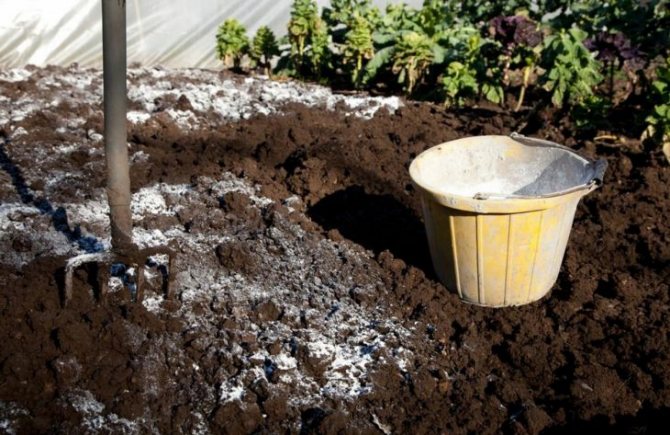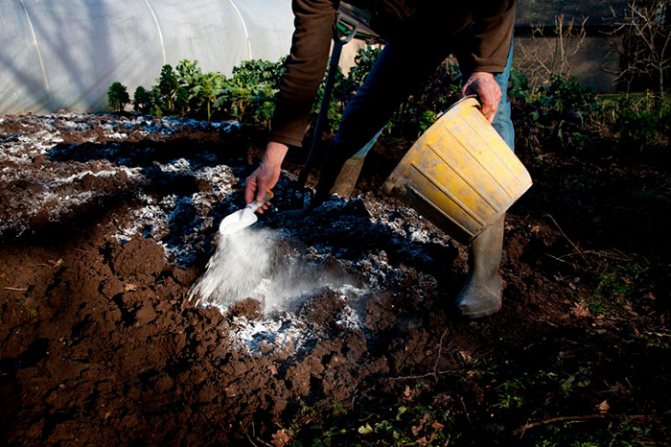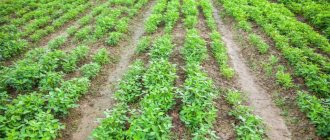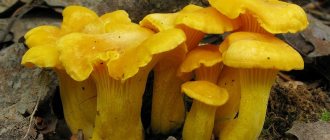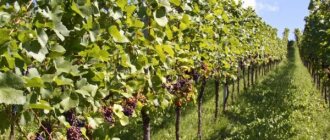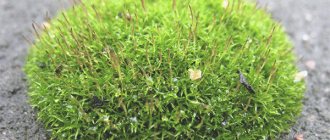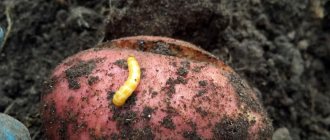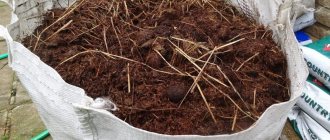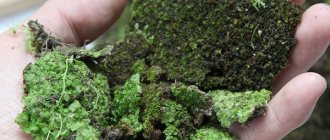Category: Organic Fertilizers Read: 8 min Views: 530
Lime is widely used in construction and agriculture. Slaked lime is obtained by mixing dry matter with water. In horticulture, lime is used to deoxidize the soil, correct the composition of the fertile layer and to protect trees from harmful insects using whitewashing. Consider all the ways to use this material in the country, as well as the process of preparing a working solution.
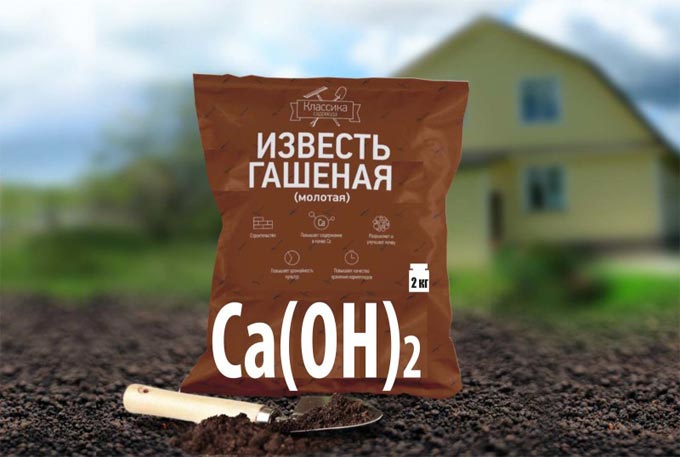
What is fluff lime?
The substance consists of processed limestone that has passed the slaking stage. The lumpy component is treated with water - the substance passes from oxides to hydroxides.
For 1 kg of the composition, 1 liter of water is used. Pour it only with cold liquid.
If extinguished with hot water, then the elements of lime will turn into an insoluble state and will not be able to produce the desired effect.
After quenching, the volume of the mixture doubles. Cooking fluff is carried out in an iron enamel bowl. Water is added in small portions, gradually mixed.
The use of quicklime in horticulture takes place. It is sprinkled with soil, and the material is recycled due to moisture and rain.
Getting rid of the wireworm
This type of insect causes quite a lot of harm to the crop, so you can use various measures and procedures to drive it out. If it is possible to get rid of the pest, then the quality of the crop will improve markedly. This beetle often reproduces in acidic soil. If you lower this indicator, then the females simply will not be able to lay eggs, which means that gradually there will be no wireworm left in the garden. In this case, the lime is applied in a small amount. For each meter, the addition of 0.5 kg of the composition is sufficient. Further, the site must be watered, after which you need to wait a few days. After that, dig up the garden again and moisten the soil. When planting potatoes, it is recommended to add a small amount of ash to each hole.
What does lime slaking mean?
Ordinary limestone is an organic composition in the form of large lumps. Before applying lime to the soil, it is treated with water in order to convert magnesium and calcium oxides into hydrates. In the process, spontaneous decomposition of products occurs, small particles are formed. Their size is responsible for the quality of the mix. The reaction is accompanied by the release of a large amount of heat. Lime contains:
- calcium hydroxide;
- magnesium hydroxide;
- potassium;
- water.
On the features of the use and benefits of lime for the garden
Fluff helps to neutralize the acidity of the earth, enriches the substrate with useful minerals. For each pH level of the environment, its own norms are provided, and you also need to know which lime is best applied to the soil.


How to determine the increased acidity of the soil?
The pH value of the soil must be determined before liming begins.
Neutral and alkaline soils are not treated: an excess of alkali in the soil will lead to wilting of many crops.
You can determine acidity as follows:
- Using litmus strips. They are sold in flower and food stores. A small amount of soil is applied to a piece of paper, and then the resulting color is compared on a scale.
- Application of a pH meter.Few of the summer residents have such a device, but if it is available, they examine a handful of soil. The device displays the exact acidity value.
- Research of soil samples in special laboratories. The soil is collected from the plots and given for research; about 150 rubles are paid for each sample.
- A handful of soil is mixed with acetic acid. If there is a hissing sound, the soil is alkaline or neutral. In an acidic earth, there is no reaction.
You can determine the acidity of the soil by the plants growing on it (crops that prefer an acidic environment will grow well: horsetail, wheatgrass, woodlice, sorrel, buttercups, clover, wormwood, etc.), as well as by the following signs:
- Formation of a soil crust on the surface.
- After watering and rain, pits form with reddish water.
- Wet yellow streaks form on the ground.
Why fight the acidity of the soil?
The low pH value of the earth negatively affects the growth of most plants: plantings die or develop poorly. These crops include:


It should be borne in mind that some garden crops prefer acidic soil, so in the country you need to set aside a separate place for them with acidic soil. These include:
How often is liming done?
The procedure is done every 4 years, with active cultivation of crops - every 3 years. It is during this period of time that the repeated acidification of the soil occurs. Garden lime is applied in the autumn or spring. In the spring, when the snow has not yet completely melted, the mixture is spread over the beds so that some of the useful elements fall deep into the soil. Application in the fall will allow the soil to completely assimilate slaked lime during the winter and absorb all the useful minerals.
Norms and rules for the introduction of lime into the soil
For each type of substrate and acidity level, a certain amount of lime is applied.
The lower the pH value, the more limestone is required to raise the index.
It is necessary to apply the mixture correctly so as not to provoke an excess of calcium. The characteristics of the acidity index depending on the type of substrate are shown in the following table.
Soil type
| PH value | ||
| Clay and loamy, g / m 2 | Sandy and sandy loam, g / m 2 | |
| 4 and below (very acidic) | 600-900 | 400-500 |
| 4.1 - 4.5 (strongly acidic) | 500-800 | 300-400 |
| 4.6 - 5 (mildly acidic) | 400-700 | 200-300 |
| 5.1 - 5.5 (slightly acidic) | 300-600 | Do not lime |
| 5.5 - 6 (almost neutral) | Do not lime | Do not lime |
Lime is embedded 20 cm into the soil. The procedure is carried out when digging the earth in spring or autumn. The composition is distributed over the site in a thin layer. The ridges, which are intended for growing crops that love the acidic environment of the earth, do not lime.
In the spring, the use of fluff lime in the garden begins 10 days before the start of planting seedlings. The dry composition is extinguished with water: 1 liter of settled water is used for 1 kg of limestone. To obtain a liquid solution, the substance is diluted in a 1: 3 ratio.
Carrying out liming
Basically, the soil is dug up in the fall. At the same time, it is better to bring fluff. Digging should be carried out after harvesting and removing the roots and tops of the plants. Fertilizers are spread over the entire surface of the site, after which the soil is turned over so that the entire sprayed surface is below. According to experienced gardeners, you should not level the ground and break up lumps, so moisture will accumulate in the soil better.
When digging the earth, fertilizers are simultaneously applied, while the top layer is slightly removed, and the subsoil is loosened by a couple of centimeters, adding 150 grams of lime composition for each meter. The layer is mixed with the soil, after which it is covered with clean fertile soil from above.
In the spring, you can also apply fertilizers, just add them in small amounts, carrying out a light digging.Most often, such manipulations are carried out before planting plants that grow poorly on acidic soil. Such manipulations are done 7 days before sowing the seeds. The main thing is to keep the humidity of the treated area. It is better to do a similar procedure on damp ground.


On the use of lime together with fertilizers
Fluff treatment is combined with top dressing. Use mineral complexes containing nitrogen, phosphorus, potassium. It is advisable to use formulations without calcium and magnesium, since these elements are contained in limestone.
A mixture of slaked lime (fluff) with manure forms insoluble complexes that are not absorbed by the soil and prevent the absorption of minerals.


Weed control
Soil liming contributes to the destruction of weeds that love an acidic environment. After processing, their roots and shoots die. Plants that are characteristic of an alkaline and neutral environment begin to be sown on the site, so an additional herbicide treatment can be carried out.
Fighting the wireworm
These are the larvae of the click beetle. They live in the soil, feed on the roots and roots of plants. Insects spread well and live in an acidic environment. After liming, their numbers are significantly reduced.
Weed control
Thanks to lime, the fluff can effectively protect the beds from weeds. A very good result can be achieved on acidic soil, where wood lice are actively growing. This type of weed is very tenacious, so it has to be weeded out regularly. It is better to use other methods, for example, to create conditions under which the weed simply cannot survive. It is recommended to add chalk or ash to the soil in the autumn; the use of lime will be an excellent solution. If you reduce the acidity, then the weed will disappear. To do this, for each square meter, it is enough to pour a glass of lime.
Application in horticulture
Fluff is used for whitewashing tree trunks in gardens and enriching compost with minerals, as well as preventing its acidification.
How to dilute lime to whitewash trees?
To obtain a solution of the desired consistency, 1 kg of the mixture is diluted with 3 liters of water. Lime mortar is used to lubricate tree trunks: it helps protect them from direct sunlight and pest attacks. Processing is recommended in the spring. They tear off the old bark and cover it with a limestone solution.


The downside is that the mixture is quickly washed off the trunks in adverse weather conditions, so the addition of other components is recommended. Recipe:
- 300 g of sandy clay;
- 1 kg of dried mullein;
- 200 g of copper sulfate powder;
- 1 kg of slaked lime;
- 10 liters of settled water.
All components are mixed and left to swell for 2-3 hours. Then the tree trunks are coated. Clay provides additional anchoring to the bark. Such processing is carried out in September for the winter.
Fluff to improve the quality of compost
Any organic material is added to the compost pit. Then they begin to ferment and new mineral complexes are formed. When organic matter decomposes, a large amount of acid is released, which delays the fermentation process. Slaked lime has the property of neutralizing an acidic environment, accelerating the activity of microorganisms, eliminates the formation of unpleasant odors.
Whitewashing trees
An inexpensive and effective tool for whitewashing trees is obtained from lime. It will protect the bark from frost damage in winter, sunburn in summer and pests in spring. The procedure can be carried out in spring and autumn. However, if it was not carried out on time, then the trunks can be processed in the summer. This must be done every year, because a layer of such whitewash is washed off under the influence of precipitation.
Before processing trees, they need to be prepared: to clear the bark of lichens and eliminate its dead areas. Next, a solution is prepared, for this, water 1: 3 is added to the lime. This “milk” is applied to the trunks of trees and shrubs.
Since the solution turns out to be very light, it does not linger well on the surface of the bark and is instantly washed off by rains, it is worth fixing it with a paste. For 1 kg of lime, 150 g of flour brewed in boiling water is used. You can use clay instead of paste, but its amount should be slightly higher: 300 g per 1 kg of lime. It is also useful to add mullein there, but then the composition will need to be insisted for 3-4 hours. Another ingredient that is useful to add to such a whitewash is copper sulfate. For a bucket of "milk" 250-300 g of substance.


Safety at work
When preparing a limestone solution and in contact with it, precautions must be taken. When slaking lime, a thermal reaction occurs, active bubbling and splashing is observed. To prevent the components from getting on the skin, adhere to the following rules:
- wear protective eyewear;
- use disposable rubber gloves, a mask to protect the respiratory tract;
- hair is tied in a bun and covered with a scarf;
- smoking and eating during work is prohibited.
Fluff lime is sold ready-made in specialized stores. You can also make it yourself from quicklime limestone. Treatment of the site with lime added to the substrate at the right time significantly improves the quality of the soil, enriches it with useful minerals, protects it from weeds and pests.
Slaked lime - fluff, use in the garden and in the garden
Serving not only as a fertilizer, helping gardeners grow plants, slaked lime in the broad sense of the word “application” boasts many. Slaked lime - we introduce fluff to reduce the acidity of the soil, we resort to its help in pest control and to achieve many other goals. Fluff is a mineralized substance used in summer cottages and other areas for as long as I can remember, it means a lot when growing plants. But first, let's figure it out.
Fighting the bear
These pests, like wireworms, are very fond of an acidic environment, therefore, lime application is relevant in the fight against them. If you add 700 grams of lime for each meter of soil, then shed the soil and dig it up after a while, then the acidity will decrease. Consequently, the conditions for the existence of beetles will become less attractive.


Slaked lime - fluff, use in the country garden and in the garden
How to turn quicklime into fluff
Lime is a fertilizer in the form of a kind of organic matter, which is perfectly part of such a necessary business as natural farming. It is characterized by safety for plants in the garden and garden (with proper use).
If it is impossible to buy a ready-made fluff, we get it ourselves. To do this, fill in quicklime with water (the proportion is approximately 1: 1), taking into account an important point: during cooking, the use of hot water in the process is absolutely excluded, because the final substance will simply lose its properties. After the end of the reaction process, stir the contents thoroughly. Next, we look at what we want to use on the site in the future: if milk of lime, then dilute with water 1 and 3, if lime dough - 1 to 1.5.
This lime is very effective in feeding and protecting numerous garden and horticultural plants. We use fluff both individually and in combination with many substances. Slaked lime, rich in calcium, potassium and magnesium, is very necessary for the life of cultivated plants.
Where and how gardeners use fluff
- In the fight against weeds and pests.
- In composting.
- White shrubs and trees.
- By liming the soil, we reduce the acidity of the soil, while improving its structure (lumpiness comes and flowability decreases).
How to fight in a summer cottage with slaked lime:
With weeds
We use slaked lime to suppress and exterminate some weeds, for which in the autumn we carry out a fairly thorough liming of the soil (300-400 g / sq. M). As a result, weeds such as horsetail, wheatgrass, and woodlice with horse sorrel have every chance of dying.
With a wireworm and a bear
The fluff will help in the garden in the fight against the wireworm and the bear eating everything and everyone. At the same time, we bring its amount into the ground without regretting it - 0.5-0.7 kg / sq. m, strait and dug up everything after introduction (or loose). Females of the above pests dislike neutral and slightly alkaline soil, so they simply do not lay their eggs in it.
We normalize the contents of the compost pit (box) in the garden
We add lime to them when it is necessary to process such “acidic” materials as sawdust, pine needles, pieces of wood and bark into compost. This list also includes soil with acidic soil cut for future compost. A separate plus in this case can be considered the accelerated decomposition of materials in the box.
Why is the increased acidity of the soil dangerous?
An acidic environment is simply ideal for the development of many types of fungus and bacteria, but useful components are clearly not enough. Very often, on such soil, cultivated plants simply cannot take root, since there is insufficient development of the root system. If you continue to apply fertilizers to such soil, then it will be a waste of time, because due to the reaction with alkali, the compositions lose their qualities. That is why it is important to apply lime in the spring or autumn to make the soil less acidic, while the soil is saturated with phosphorus and calcium, and the level of nitrogen and magnesium also increases.
To increase yields, you need to be able to correctly calculate the rate of application of funds, if we are talking about a vegetable garden, then certain rules should be taken into account:
- if the soil is heavy or clay, you need to add 500-700 grams per meter;
- for loam, 400 grams will be sufficient for the same volume;
- with light soil, 250-400 grams of lime will be required.
These standards must be followed, since an overdose is as harmful as a lack of a substance. If the soil is oversaturated with alkali, then the plants will not be able to assimilate the necessary trace elements. Simultaneous application of lime and manure is unacceptable, as this leads to the formation of insoluble compounds. The result will be a small harvest due to a lack of essential nutrients.
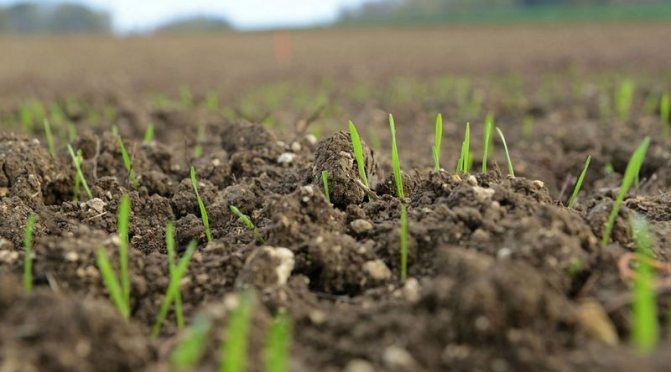

Comparison of slaked and quicklime
Lime is a substance that is obtained by burning carbonate rock. An example is chalk, limestone. As for slaked lime, it is calcium hydroxide. The product is an alkaline agent, it looks like a whitish powder that does not dissolve well in liquid. This powder is popularly called fluff. The product can be extinguished by mixing the calcium oxide compound with water.
Quicklime is obtained by heat treatment of the same material. This is calcium oxide. It looks like a granular material. When palpating, you can feel the warmth from the product.
Quicklime is practically not used for the garden. But the product is used to create some types of bricks, various refractory materials and in other areas.
The main difference between slaked and quicklime lies in the formula of the substances. The first is calcium hydroxide, and the other is the oxide of the same element. The first substance reacts weakly with water, and the second is converted into slaked lime and generates heat.The release form is also different: the first component is powder, and the second is granules. In terms of commonality between the two products, slaked lime is obtained by mixing water with quicklime.
Determination of soil acidity
To determine acidity, a special device is used - Ph meter. But ordinary summer residents hardly have it. Litmus tests are more available. They do not provide accurate indicators, but by color you can determine how acidified the soil is:
- blue tint of paper - calcareous soil - alkaline or slightly alkaline;
- green tint - neutral;
- beige color is typical for loam;
- red and its shades - acidic soil.
If there is no place or time to buy litmus paper, then you need to go out into the garden and carefully examine the soil. If there is a gray-white bloom, such as that of ash, then lime must be added to the soil in autumn or spring. The amount of lime fertilizers is calculated based on the degree of acidification.
Video: Whitewashing garden crops
Find a low area in the garden where water usually accumulates and see what color it is. If it is brownish-rusty with a film, this also indicates an increased acid level.
Lime for soil in the garden is used when weeds begin to multiply there - dandelion, horsetail or mullein.
There is a popular method for determining the presence of acid - this is vinegar. A few drops of vinegar are poured onto the guest of the earth. If there is a hiss, but the soil does not change color, then there are enough carbonates in it. If the soil has turned white and hissed, then you need to decide when and how best to apply lime to the soil - in the fall or spring.
Useful properties of fluff for the garden and vegetable garden
Fluff has the following beneficial properties:
- protects plants from diseases;
- increases the adaptive properties of plants, helping to counteract various harmful factors;
- improves crop nutrition;
- holds nitrogen in the soil;
- accelerates the dissolution of various substances in a liquid;
- accelerates the expansion of the root system of the plant;
- promotes faster decomposition of organic compounds.
Thanks to the fluff, it turns out to stabilize the upper layer of the soil and improve its chemical composition. In addition, the effect of toxic metals is leveled.
How to use fluff for the vegetable garden and garden?
There are the following main ways to use fluff:
- deoxidation (liming) of the soil;
- use with other fertilizers;
- as a means for controlling weeds and pests.
With fluff, they not only process trees and large shrubs from pests, but also feed the soil in order to increase the fertility of the soil, as well as reduce the level of its acidity.
When using fluff in the garden, you must remember the following nuances:
- On the time of fertilizer application. If the soil has not been exploited too much, then liming the garden is enough every 4 years. Otherwise - every 3 years.
- It is forbidden to use in parallel with humus.
- Recommended for use on heavy ground.
- Cannot be stored indoors, as upon reaction with water, it will begin to heat up and evaporate, thereby harming the human body.
- It is allowed to use in parallel with wood ash, especially for processing plants that do not react well to chlorine.
Soil deoxidation with slaked lime: when and for what purpose?
Deacidification (liming) of the soil is a process to improve the quality and structure of acidic soils. It is carried out through the application of fertilizers that contain a large amount of calcium. This also applies to fluff.
This is required for the correct process of soil formation, increasing yields, and improving the availability of nutrients for plants. Soil acidification in the garden indicates that calcium is being displaced by hydrogen ions.The mineral deficiency is replenished precisely by liming. The procedure improves metabolic processes between plant cells, saturates the soil with magnesium and other useful substances, helps to loosen the earth, improve air exchange in it.
It is required to alkalize the soil with the help of fluff if there are plans for the future planting in the garden of such crops as: cabbage, carrots, garlic, onions, beets, spinach, celery, alfalfa. They will not yield a good harvest if the soil is acidified. They will not be able to fully develop on such a site. This also applies to some colors.
For cucumbers, grapes, corn, cereals, legumes, sunflowers, lettuce, neutral soil is required, but adding fluff will not harm them.
For fruit and berry crops, the acidity should be as follows:
- pears and apple trees - up to 6.5%;
- plums - up to 7%;
- raspberries, gooseberries, blackberries - up to 5.5%;
- currants - up to 6%;
- strawberries - up to 5.2%.
If there are deviations from such indicators, then it is required to deoxidize the soil in the garden.
Fluff is supposed to be brought in during plowing the soil in the fall. After that, mix with the soil to activate the action. If the territory of the garden is small, then the powder must be scattered by hand and immediately mixed with the soil. Fertilization is required gradually. The algorithm of actions is as follows:
- Initial application. First you need to determine the exact acidity level. The deoxidation procedure is carried out in parallel with digging. The main fluff addition is usually done once every 3-4 years.
- Re-adding. This is required if the acidification level of different areas in the garden is different. The procedure is carried out dosed and only on the necessary areas. Particular attention should be paid to those plants that are most affected by a decrease in the level of calcium in the soil.
It is recommended to carry out the main deoxidation in the garden 2 years before the trees and shrubs are planted. During this time, the acidity level will have time to recover.


For 1 sq.m. sour land requires up to 650 g of fluff. If the soil is moderately acidic - 520 g, and if it is not too acidic - 450 g. A 10-liter container can hold 25 kg of fluff. The composition must be distributed as evenly as possible.
Use with other fertilizers
If you plan to use fluff together with other compositions, then you must take into account some features:
- do not mix with crushed chalk, dolomite flour, marl;
- it is allowed to make a mixture with ground limestone (calcium-type organic matter).
To the question of which dolomite flour or fluff is better for the garden, you can give the following answer. If we compare the calcium content, then in fluff it is 8% less than in dolomite flour.
As for magnesium, the fluff does not contain such an element, but its specific gravity in dolomite flour is 40%. Thanks to this compound, photosynthesis takes place.
Fluff works faster than dolomite flour, but after using it, the plants are more difficult to absorb phosphorus. The only advantage of fluff compared to dolomite flour is its lower cost.
Fertilizers
It is believed that carbonates cannot be used simultaneously with manure and other nitrogen fertilizers, since they neutralize the action of each other. But there are substances that are even recommended to be added to manure or compost heap. to enhance the activity of microorganisms:
- dolomite flour;
- marl;
- travertine or calcareous tuff - a rock with a small amount of calcite;
- a piece of chalk;
- lake lime, which is formed when water bodies dry out.
The following substances are suitable for reducing soil acidity and plant nutrition, but they are not used simultaneously with manure:
- wood ash;
- waste cement;
- shale combustion products;
- carbide lime - a product of calcium carbide processing;
- garden lime fluff - use in the garden and horticulture is limited to whitewashing trees;
- open-hearth slag.
Phosphate rock and limestone have a similar effect - they alkalize the soil, but they cannot be introduced into the soil together. The fact is that a weakly acidic medium is needed to dissolve phosphorus.
Excessive application of carbonates can stop the absorption of phosphates by plants. It is better to apply lime as a fertilizer for the garden separately, and then test the soil for acidity.

